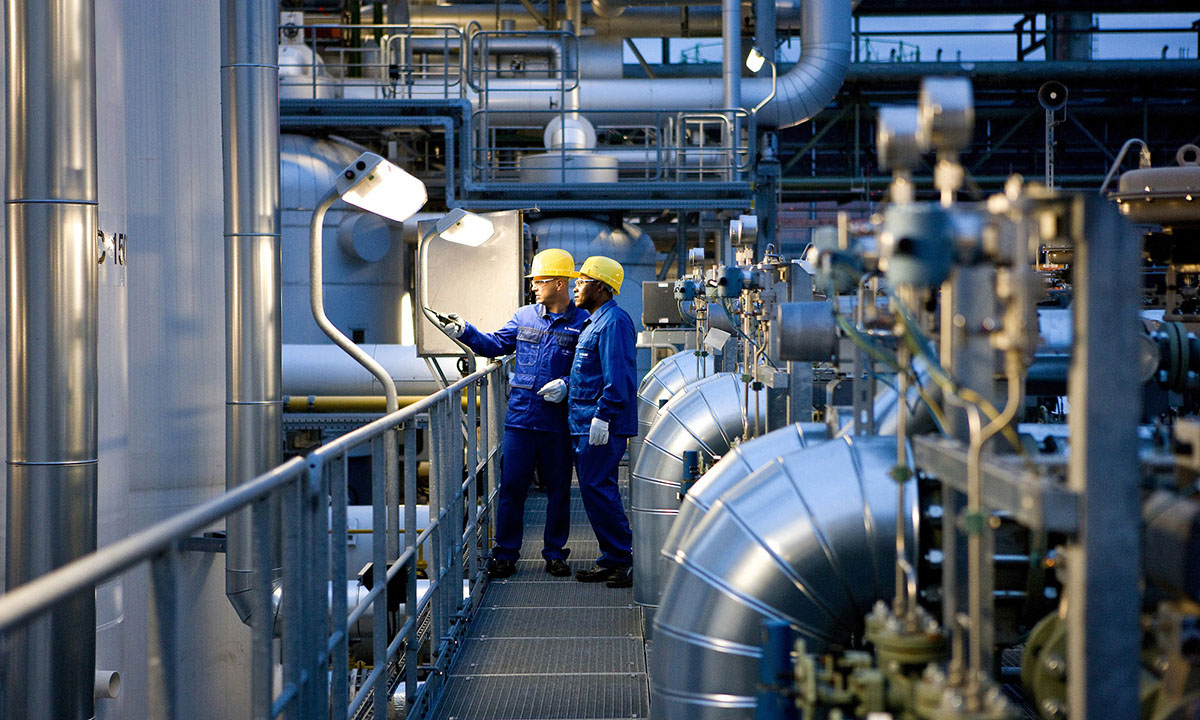Home>Finance>Which Sector Of Germany’s Economy Had The Highest GDP?


Finance
Which Sector Of Germany’s Economy Had The Highest GDP?
Published: October 29, 2023
Discover which sector of Germany's economy, particularly in finance, had the highest GDP and its impact on the country's overall growth.
(Many of the links in this article redirect to a specific reviewed product. Your purchase of these products through affiliate links helps to generate commission for LiveWell, at no extra cost. Learn more)
Table of Contents
Introduction
Germany is known for its powerful economy and is often referred to as the powerhouse of Europe. As the largest economy in the European Union, Germany plays a significant role in shaping the region’s financial landscape. Understanding the composition of Germany’s economy is crucial in comprehending its economic strength and the factors driving its growth.
In order to gauge the economic performance of a country, one key metric often used is the Gross Domestic Product (GDP). The GDP measures the total value of goods and services produced within a country’s borders over a specific period of time. By analyzing the various sectors that contribute to the GDP, we can gain insights into the key drivers of economic growth in Germany.
This article aims to provide an overview of Germany’s economy and analyze the sectors that have had the highest GDP contribution. By examining the manufacturing, services, and agriculture sectors, we can better understand the strengths and dynamics of Germany’s economic landscape.
Overview of Germany’s Economy
Germany has a highly developed and diversified economy that is characterized by a strong focus on exports, technological innovation, and a well-educated workforce. It is the world’s fourth-largest economy by nominal GDP and the largest by GDP within the European Union.
The country has a wide range of industries that contribute to its economic growth. Some of the key sectors include manufacturing, automotive, pharmaceuticals, machinery, finance, and information technology. Germany’s reputation for quality craftsmanship and engineering excellence has positioned it as a global leader in manufacturing.
The country’s economic success can be attributed to its commitment to research and development, fostering an environment conducive to innovation and technological advancement. This has helped German companies stay competitive and maintain a strong global presence.
Furthermore, Germany benefits from a highly skilled and educated workforce. The country places a strong emphasis on vocational and technical training, ensuring a steady supply of skilled workers across industries. Additionally, its robust social welfare system and labor market flexibility contribute to a stable and productive workforce.
Germany’s economic stability and strong industrial base have made it an attractive destination for foreign investors. Its central location in Europe, extensive transportation infrastructure, and membership in the European Union provide businesses with access to a large consumer market.
Despite these strengths, Germany also faces some challenges. An aging population and demographic trends pose long-term challenges to its labor market and social security system. Additionally, rapid technological advancements and the shift towards digitalization require continuous adaptation and investment.
Overall, Germany’s economy stands as a global powerhouse, driven by its strong manufacturing base, commitment to innovation, and highly skilled workforce.
Calculation of GDP
Gross Domestic Product (GDP) is a key economic indicator that measures the total value of all goods and services produced within a country’s borders during a specific time period, usually a year. It provides a comprehensive measure of economic activity and is often used to compare the economic performance of different countries or analyze the growth of an economy over time.
The calculation of GDP involves adding up the value of consumption, investment, government spending, and net exports (exports minus imports). This can be done using different approaches, including the expenditure approach, income approach, and production approach.
The expenditure approach calculates GDP by summing up the spending on final goods and services by households, businesses, government, and net exports. This includes household consumption, business investment, government expenditure on goods and services, and the value of exports minus imports.
The income approach calculates GDP by summing up the incomes earned by individuals and businesses in the production of goods and services. This includes wages and salaries, rents, interest, profits, and other forms of income.
The production approach calculates GDP by summing up the value added at each stage of production. This involves adding up the value of all intermediate goods and services used in the production process and the final value of the finished goods and services.
In Germany, the calculation of GDP is undertaken by the Federal Statistical Office (Destatis), which collects data from various sources, including surveys, administrative records, and company reports. The data is then processed and analyzed to derive the final GDP figures.
GDP is an important measure of a country’s economic health, as it reflects the overall level of economic activity and can provide insights into factors such as consumer spending, investment, and international trade. By analyzing the different components of GDP, policymakers and economists can make informed decisions regarding economic policies and strategies.
It is worth noting that while GDP is a widely used indicator, it does have limitations. It does not account for factors such as income distribution, quality of life, or sustainability. Additionally, it may not capture the full extent of informal or underground economic activities.
Sector Analysis
To gain a deeper understanding of Germany’s economy, it is essential to analyze the different sectors that contribute to its Gross Domestic Product (GDP). The three main sectors we will focus on are manufacturing, services, and agriculture.
1. Manufacturing Sector
The manufacturing sector plays a crucial role in Germany’s economy. Known for its engineering prowess and high-quality products, Germany is renowned for its manufacturing expertise across various industries. This sector includes automotive manufacturing, machinery, chemicals, electronics, and more.
German manufacturing companies are known for their focus on innovation, efficiency, and craftsmanship. They have a strong presence in global markets and are recognized for their ability to produce technologically advanced and reliable products. The manufacturing sector generates a significant portion of Germany’s export revenue and contributes substantially to the country’s GDP.
2. Services Sector
The services sector is another important contributor to Germany’s economy. It encompasses a wide range of industries such as finance, business services, tourism, healthcare, education, and transportation. The services sector has experienced significant growth in recent years and has become a key driver of the German economy.
Germany is home to many globally recognized financial institutions and service providers. Frankfurt, in particular, is a major financial hub and is known as the banking capital of Germany. The services sector benefits from a skilled workforce, extensive infrastructure, and a strong focus on technological innovation.
3. Agriculture Sector
The agriculture sector, while not as prominent as manufacturing and services, still plays a vital role in Germany’s economy. It encompasses activities such as crop production, livestock farming, forestry, and fishing.
Germany is known for its high-quality agricultural products and strict food safety standards. The country’s agricultural sector has seen significant advancements in technology, leading to increased productivity and efficiency. However, due to limited arable land and environmental regulations, the agriculture sector’s contribution to GDP is relatively smaller compared to manufacturing and services.
It is important to note that while these three sectors are key drivers of Germany’s economy, the boundaries between them are not always clear-cut. Many industries operate at the intersection of manufacturing and services, and technological advancements have blurred traditional sector distinctions.
Manufacturing Sector
The manufacturing sector is a cornerstone of Germany’s economy and has been a key driver of its economic success. Known for its engineering prowess and precision, German manufacturing is renowned for its high-quality products, reliability, and innovation.
Germany is widely recognized as a global leader in various manufacturing industries, including automotive manufacturing, machinery, chemicals, electronics, and precision engineering. Companies such as Volkswagen, BMW, Siemens, and Bosch have established themselves as industry giants.
One of the key strengths of the German manufacturing sector lies in its emphasis on research and development (R&D). German companies invest heavily in developing innovative technologies and processes, which gives them a competitive edge in the global market.
Moreover, the sector benefits from a highly skilled workforce. Germany has a long tradition of technical and vocational training, providing workers with the necessary skills and expertise to excel in manufacturing. This focus on education and training has contributed to the sector’s ability to maintain a high level of productivity and efficiency.
The automotive industry, in particular, is a major contributor to the German manufacturing sector. German automakers are known worldwide for their engineering excellence and high-performance vehicles. The sector supports a vast network of suppliers and generates significant employment opportunities.
Additionally, Germany’s manufacturing sector has a strong focus on sustainability and energy efficiency. Companies prioritize sustainable production practices, reducing the environmental impact of their operations.
However, the German manufacturing sector is not without its challenges. Global economic uncertainties, technological disruptions, and increasing competition from emerging markets pose challenges to maintaining growth and competitiveness. Nevertheless, the sector continues to evolve and adapt to changing market dynamics.
In summary, the manufacturing sector plays a vital role in Germany’s economy, driving innovation, exports, and employment. Its strong focus on R&D, skilled workforce, and commitment to sustainability position Germany as a global leader in manufacturing.
Services Sector
The services sector is a significant contributor to Germany’s economy and has experienced substantial growth in recent years. It encompasses a wide range of industries, including finance, business services, tourism, healthcare, education, and transportation.
Germany is home to many globally recognized financial institutions, making it a leading financial center in Europe. Frankfurt, in particular, is known as the banking capital of Germany. The financial services sector plays a vital role in facilitating domestic and international trade, attracting investments, and supporting businesses in their growth initiatives.
Business services, such as consulting, information technology, and legal services, have also witnessed remarkable growth. German companies are known for their expertise in providing high-quality and specialized services to both domestic and international clients. This sector benefits from a highly skilled workforce, extensive infrastructure, and a strong focus on technological innovation.
Another significant component of the services sector is tourism. Germany is a popular tourist destination, attracting visitors from all over the world. The country offers a rich cultural heritage, stunning landscapes, historical landmarks, and vibrant cities. The tourism sector contributes to employment generation and revenue through accommodation, food services, transportation, and leisure activities.
The healthcare and education sectors are also important contributors to Germany’s services sector. Germany has a well-developed healthcare system that provides high-quality medical care to its citizens and attracts medical tourists from around the world. The education sector is renowned for its universities and research institutes, attracting international students and fostering academic excellence.
In recent years, the digital economy has emerged as a significant part of the services sector. Germany is witnessing rapid growth in the technology and digital sectors, with startups and innovation hubs gaining prominence. This development is driving job creation, technological advancement, and economic growth.
Overall, the services sector is a vital pillar of Germany’s economy. It offers a diverse range of industries that contribute to employment, innovation, and economic growth. Germany’s commitment to maintaining a skilled workforce, technological innovation, and strong infrastructure ensures the continued growth and success of the services sector.
Agriculture Sector
The agriculture sector in Germany, though not as dominant as manufacturing and services, plays a vital role in the country’s economy. The sector encompasses activities such as crop production, livestock farming, forestry, and fishing.
Germany has a diverse agricultural landscape, with a wide range of agricultural products. The country is known for its high-quality food products, stringent food safety standards, and environmentally sustainable practices.
Crop production is an essential part of the agriculture sector, with Germany being a significant producer of cereals, vegetables, fruits, and oilseeds. The use of advanced farming techniques and technology has led to increased productivity and efficiency in crop production.
Livestock farming is another crucial component of the agriculture sector. Germany has a well-developed livestock industry, particularly in dairy and meat production. The sector follows strict animal welfare regulations, ensuring the quality and safety of livestock products.
Forestry is an integral part of Germany’s agriculture sector as well. Germany has extensive forested areas, and sustainable forestry practices are followed to ensure the preservation and long-term viability of the forests. Timber and wood products contribute to both the domestic market and export industry.
Germany also has a significant fishing industry, although it operates mainly in coastal areas. The country has access to both North Sea and Baltic Sea fisheries, supporting commercial fishing activities.
While the agriculture sector in Germany contributes to the overall economy, its share of GDP is relatively smaller compared to manufacturing and services. This is primarily due to the limited availability of arable land and strict environmental regulations to preserve natural resources.
Despite its smaller contribution to the GDP, the agriculture sector plays a vital role in ensuring food security, promoting regional development, and preserving the rural way of life. Furthermore, the sector emphasizes sustainable and organic farming practices, aligning with Germany’s commitment to environmental conservation.
In summary, although the agriculture sector may not be as prominent as manufacturing and services in Germany, it still contributes significantly to the economy, ensuring food production, implementing sustainable practices, and supporting rural communities.
Comparison of Sector GDPs
When comparing the GDP contributions of the manufacturing, services, and agriculture sectors in Germany, it is evident that manufacturing and services play a more significant role in the country’s economy compared to agriculture.
The manufacturing sector has traditionally been a powerhouse in Germany’s economy, contributing significantly to its GDP. With its focus on innovation, high-quality products, and global competitiveness, the sector generates substantial export revenue and supports employment opportunities. This sector’s contribution to Germany’s GDP is notably higher than that of agriculture.
The services sector has experienced impressive growth in recent years, becoming a key driver of Germany’s economy. The financial services industry, in particular, contributes significantly to GDP, with German banks playing a vital role in Europe’s financial markets. Other service industries, such as business services, tourism, healthcare, and education, also make substantial contributions to the country’s GDP.
On the other hand, the agriculture sector, while important for ensuring food production and sustainable practices, makes a relatively modest contribution to Germany’s overall GDP. Limited arable land, strict environmental regulations, and a smaller share of the population engaged in agriculture contribute to its lower GDP share.
It is worth noting that the contributions of these sectors to GDP can vary over time due to factors such as global economic conditions, technological advancements, and shifting consumer preferences. The German economy is dynamic and constantly adapting to changing circumstances.
However, it is the combination of the manufacturing, services, and agriculture sectors that contributes to the overall economic strength of Germany. The diverse range of industries and sectors ensures resilience and stability in the face of economic challenges.
Ultimately, the comparison of sector GDPs highlights the importance of a balanced and diversified economy, with manufacturing and services sectors serving as the primary drivers of Germany’s economic growth, while the agriculture sector plays a complementary role.
Conclusion
Germany’s economy stands as a powerhouse, driven by a combination of the manufacturing, services, and agriculture sectors. The manufacturing sector, with its focus on innovation, precision engineering, and high-quality products, has long been the backbone of Germany’s economic success. The services sector, encompassing industries such as finance, business services, tourism, healthcare, and education, has experienced significant growth, contributing to employment generation and economic development. While the agriculture sector’s contribution to GDP is relatively smaller, it plays a vital role in ensuring food security, sustainability, and supporting rural communities.
Germany’s economic strength lies in its commitment to research and development, a highly skilled workforce, technological advancements, and a focus on sustainability. These factors have positioned Germany as a global leader in various industries and have attracted foreign investments to fuel further growth.
However, the German economy also faces challenges such as an aging population, global economic uncertainties, and emerging competition. Continuous adaptation and investment are necessary to maintain economic competitiveness and ensure long-term growth.
Overall, Germany’s balanced and diversified economy, with the manufacturing and services sectors at the forefront and the agriculture sector providing necessary support, has proven resilient and capable of navigating through changing economic environments. By leveraging its strengths in innovation, expertise, and sustainability, Germany is well-positioned to maintain its status as one of the world’s leading economies.














